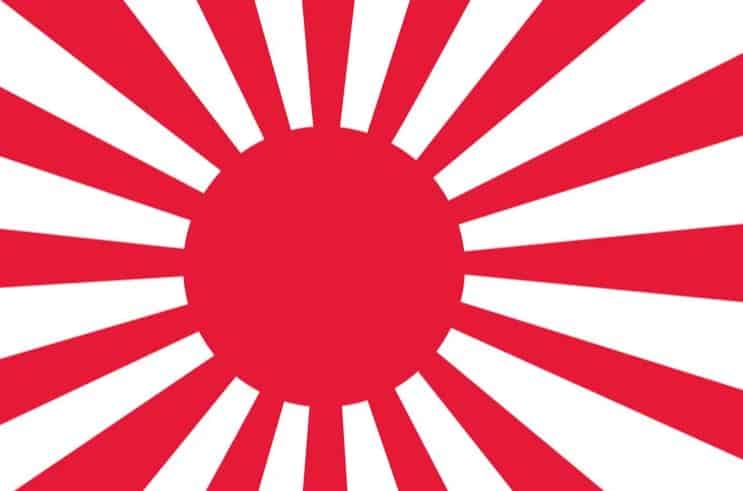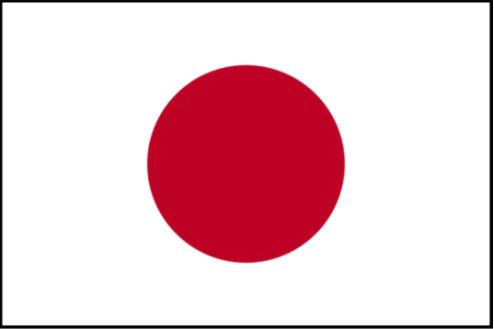The flag of Japan, also known as the Nisshōki or Hinomaru (日の丸), is a red circle on a white background. It is one of the most recognizable flags in the world, and has a rich history and cultural significance. In this article, we will explore the history of the flag of Japan, its various iterations, and how it is viewed by modern Japanese culture.
Japan Flag History
The origins of the flag of Japan can be traced back to the 7th century, during the Asuka period. At that time, Japan was divided into many small kingdoms, each with their own symbols and banners. The first recorded use of a flag resembling the modern Hinomaru was in the 12th century, during the Kamakura period. The Minamoto clan, who ruled Japan at the time, used a white flag with a red sun on it as their emblem.
Over the centuries, the design of the flag evolved and changed. During the Edo period, from the 17th to the mid-19th century, the Hinomaru became more widespread as a symbol of Japanese identity. It was used by samurai clans, as well as by ordinary people.
In 1854, Japan opened its ports to foreign trade, and the Hinomaru was used to represent the country in international dealings. In 1870, the Meiji government officially adopted the Hinomaru as the national flag of Japan.

Planning a trip to Japan?
Japan Flag Design
The design of the Japanese flag is simple yet striking. It consists of a white rectangular background with a large red circle in the center. The circle represents the sun, and is sometimes called the “rising sun.” The flag is sometimes referred to as the “Hi no maru,” which means “circle of the sun” in Japanese.
The flag has no official proportions, but the most common ratio is 2:3. The red circle is not placed in the exact center of the flag, but is slightly offset towards the hoist (the side where the flagpole is attached).
Iterations of the Flag
The Old Japan Flag
In the late 19th century, Japan underwent a period of rapid modernization and westernization. As part of this process, the government decided to adopt a new national flag that would better represent the country’s new identity as a modern, industrialized nation.
The new flag, known as the Rising Sun flag or Kyokujitsu-ki, featured a red sun with 16 rays on a white background. The design was heavily influenced by western heraldry and military symbolism, and was intended to project an image of strength and modernity.
The Rising Sun flag quickly became a ubiquitous symbol of Japan’s power and prestige, both at home and abroad. It was flown from ships, displayed at public events, and incorporated into military uniforms.

Japan Flag WW2
Unfortunately, the Rising Sun flag also became associated with Japan’s militaristic and expansionist ambitions during World War II. The flag was often flown by Japanese troops as they conquered new territories throughout Asia, and it became a potent symbol of Japanese imperialism and aggression.
The flag’s association with Japan’s wartime atrocities, including the Rape of Nanking and the Bataan Death March, has made it a highly controversial symbol in the decades since the war ended. Many people view the flag as a symbol of Japan’s past aggression and war crimes, and argue that it should not be used in official contexts.
Current Japan Flag
In 1999, the Japanese government officially adopted a law designating the Hinomaru as the national flag of Japan. This decision was made in part to distance Japan from the controversial Rising Sun flag, and to reaffirm the country’s commitment to peace and international cooperation.
Today, the Hinomaru is widely recognized as the official flag of Japan. Its simple yet powerful design has come to symbolize Japan’s unique cultural heritage, and its use is often associated with national pride and patriotism.

Cultural Significance of the Flag
The flag of Japan has deep cultural significance for the Japanese people. It is seen as a symbol of national unity and identity, and is displayed on many public buildings and private residences. The flag is also used in many official ceremonies and events, such as the opening ceremony of the Olympic Games.
The Hinomaru is also a symbol of Japan’s long history and cultural traditions. It is often depicted in artwork and literature, and is an important element of traditional Japanese clothing and design.
The flag has also been used as a source of inspiration for Japanese artists and designers. The simple yet powerful design of the Hinomaru has been incorporated into many different mediums, including fashion, architecture, and graphic design. The flag has become an iconic symbol of Japan, recognized and respected around the world.
In modern Japanese culture, the flag of Japan is viewed with a great deal of pride and reverence. It is often seen as a symbol of the country’s unique identity, and a reminder of its rich cultural heritage. Many Japanese people feel a deep connection to the flag, and display it proudly on national holidays and other important occasions.
At the same time, there is also some controversy surrounding the flag, particularly with regards to its use during the Second World War (WW2). Some people view the flag as a symbol of Japan’s militaristic past, and argue that it should not be used in official contexts.
In recent years, there has been a growing movement in Japan to create a new national flag that better represents the country’s modern values and aspirations. Some have suggested incorporating elements of Japan’s natural landscape or cultural heritage into the design, while others have proposed more radical departures from the traditional Hinomaru.
Despite these debates and discussions, however, the flag of Japan remains an important and enduring symbol of the country’s national identity. It is a powerful reminder of Japan’s long and complex history, and a source of inspiration and pride for many people around the world.
Summing it up
The flag of Japan, with its simple yet powerful design, has a rich and complex history. From its origins in the 7th century to its adoption as the national flag of Japan in the 19th century, the Hinomaru has played an important role in the country’s cultural and political life.
While there have been various iterations of the flag over the years, the Hinomaru remains the only flag officially recognized as the national flag of Japan. It is a symbol of national unity and identity, and a powerful reminder of Japan’s unique history and cultural heritage.
As Japan continues to evolve and change, there will no doubt be ongoing discussions and debates about the future of the flag. But for now, the flag of Japan remains a powerful and enduring symbol of the country’s past, present, and future.
While the Rising Sun flag remains a contentious symbol in some parts of the world, the Hinomaru has come to be recognized as the official flag of Japan. Its enduring simplicity and power have made it a source of inspiration and pride for many people around the world, and it is likely to remain an important symbol of Japan’s cultural and political identity for years to come.

